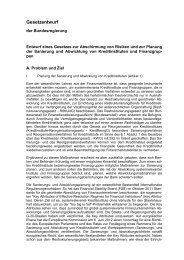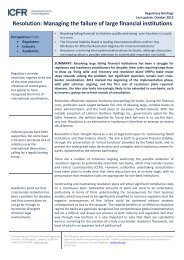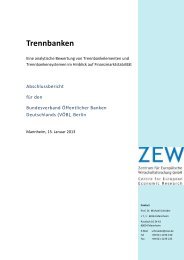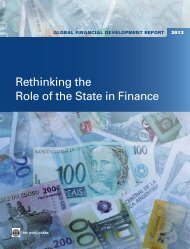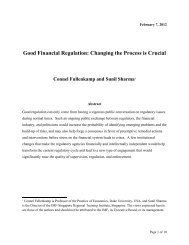3 Issuing costs of state guaranteed bonds - Financial Risk and ...
3 Issuing costs of state guaranteed bonds - Financial Risk and ...
3 Issuing costs of state guaranteed bonds - Financial Risk and ...
You also want an ePaper? Increase the reach of your titles
YUMPU automatically turns print PDFs into web optimized ePapers that Google loves.
3 <strong>Issuing</strong> <strong>costs</strong> <strong>of</strong> <strong>state</strong> <strong>guaranteed</strong> <strong>bonds</strong><br />
analysis in the present study is the Z-spread for the reasons outlined above. However, the other<br />
measures will be used to test for the robustness <strong>of</strong> the empirical results.<br />
Table 3: Credit spread measures<br />
Spread<br />
measure<br />
Bloomberg<br />
code<br />
Summary Issues<br />
Yield spread yas_ytm_mid Difference between yieldto-maturity<br />
<strong>of</strong> the bond<br />
<strong>and</strong> yield-to-maturity <strong>of</strong> a<br />
benchmark with similar<br />
but not necessarily<br />
identical maturity.<br />
Interpolated<br />
spread<br />
(I-spread)<br />
Optionadjusted<br />
spread<br />
(Z-spread)<br />
Source: O' Kane <strong>and</strong> Sen (2004)<br />
Pricing sources<br />
blp_i_sprd_mid Difference between yieldto-maturity<br />
<strong>of</strong> the bond<br />
<strong>and</strong> yield-to-maturity <strong>of</strong> a<br />
benchmark with the same<br />
maturity.<br />
blp_z_sprd_mid Parallel shift <strong>of</strong> the<br />
benchmark required in<br />
order to meet the yield-tomaturity<br />
<strong>of</strong> the credit risky<br />
bond.<br />
Yield-to-maturity assumptions: Assumes<br />
reinvestment at same rate as the yield, <strong>and</strong><br />
assumes the bond is held to maturity.<br />
Hence, reinvestment risk unaccounted for.<br />
Maturity mismatch: Can be biased as<br />
maturities may not be the same <strong>and</strong> the<br />
benchmark bond changes over time.<br />
Account <strong>of</strong> term structure <strong>of</strong> interest rates:<br />
No<br />
Yield-to-maturity assumptions:<br />
Reinvestment risk unaccounted for, as<br />
above.<br />
Maturity mismatch: Benchmark rates are<br />
linearly interpolated. Gets around the<br />
maturity mismatch problem <strong>of</strong> yield spread.<br />
Account <strong>of</strong> term structure <strong>of</strong> interest rates:<br />
Roughly<br />
Yield-to-maturity assumptions: Assumes<br />
reinvestment at benchmark plus z-spread so<br />
future expectations <strong>of</strong> interest rates<br />
accounted for, reducing reinvestment risk.<br />
Maturity mismatch: Parallel shift <strong>of</strong><br />
benchmark overcomes maturity mismatch<br />
problem.<br />
Account <strong>of</strong> term structure <strong>of</strong> interest rates:<br />
Yes<br />
There are two Bloomberg sources for the benchmark curve. Bloomberg Generic (BGN), which is<br />
based on a consensus <strong>of</strong> prices provided by brokers/dealers; <strong>and</strong> the Composite Bloomberg Bond<br />
Trade (CBBT), which derives a composite <strong>of</strong> executed prices only.<br />
Our preferred pricing source is CBBT. This is because CBBT relies on real trade data only while BGN<br />
does not.<br />
However, as data on all executed trades are not readily available, BGN serves as a complementary<br />
pricing source, ins<strong>of</strong>ar as it is based on a wider range <strong>of</strong> brokers/dealers than CBBT. For this<br />
reason, BGN will be used for a robustness check <strong>of</strong> the main results based on CBBT.<br />
35



